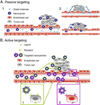From Diagnosis to Treatment: Clinical Applications of Nanotechnology in Thoracic Surgery
- PMID: 27112260
- PMCID: PMC4851727
- DOI: 10.1016/j.thorsurg.2015.12.009
From Diagnosis to Treatment: Clinical Applications of Nanotechnology in Thoracic Surgery
Abstract
Nanotechnology is an emerging field with potential as an adjunct to cancer therapy, particularly thoracic surgery. Therapy can be delivered to tumors in a more targeted fashion, with less systemic toxicity. Nanoparticles may aid in diagnosis, preoperative characterization, and intraoperative localization of thoracic tumors and their lymphatics. Focused research into nanotechnology's ability to deliver both diagnostics and therapeutics has led to the development of nanotheranostics, which promises to improve the treatment of thoracic malignancies through enhanced tumor targeting, controlled drug delivery, and therapeutic monitoring. This article reviews nanoplatforms, their unique properties, and the potential for clinical application in thoracic surgery.
Keywords: Lung cancer; Nanotechnology; Nanotheranostics; Thoracic surgery.
Copyright © 2016 Elsevier Inc. All rights reserved.
Figures








Similar articles
-
Nanotechnology applications in thoracic surgery.Eur J Cardiothorac Surg. 2016 Jul;50(1):6-16. doi: 10.1093/ejcts/ezw002. Epub 2016 Feb 2. Eur J Cardiothorac Surg. 2016. PMID: 26843431 Free PMC article. Review.
-
Nanotechnology in thoracic surgery.Ann Thorac Surg. 2010 Jun;89(6):S2188-90. doi: 10.1016/j.athoracsur.2010.02.111. Ann Thorac Surg. 2010. PMID: 20494008 Free PMC article.
-
Image-guided localization for video-assisted thoracic surgery.J Thorac Imaging. 1997 Oct;12(4):285-92. doi: 10.1097/00005382-199710000-00006. J Thorac Imaging. 1997. PMID: 9368223 Review.
-
Defining quality in the surgical care of lung cancer patients.J Thorac Cardiovasc Surg. 2017 Oct;154(4):1397-1403. doi: 10.1016/j.jtcvs.2017.05.100. Epub 2017 Jun 9. J Thorac Cardiovasc Surg. 2017. PMID: 28676186 No abstract available.
-
What's new in general thoracic surgery.J Am Coll Surg. 2001 Jun;192(6):737-49. doi: 10.1016/s1072-7515(01)00933-4. J Am Coll Surg. 2001. PMID: 11400968 Review. No abstract available.
Cited by
-
New perspectives in nanotherapeutics for chronic respiratory diseases.Biophys Rev. 2017 Oct;9(5):793-803. doi: 10.1007/s12551-017-0319-x. Epub 2017 Sep 15. Biophys Rev. 2017. PMID: 28914424 Free PMC article.
-
Nanotechnology development in surgical applications: recent trends and developments.Eur J Med Res. 2023 Nov 24;28(1):537. doi: 10.1186/s40001-023-01429-4. Eur J Med Res. 2023. PMID: 38001554 Free PMC article. Review.
References
-
- Farokhzad OC, Langer R. Impact of Nanotechnology on Drug Delivery. ACS Nano. 2009;3(1):16–20. - PubMed
-
- Ferrari M. Cancer nanotechnology: opportunities and challenges. Nat Rev Cancer. 2005;5(3):161–171. - PubMed
-
- Howlader N, Noone AM, Krapcho M, Garshell J, Miller D, Altekruse SF, Kosary CL, Yu M, Ruhl J, Tatalovich Z, Mariotto A, Lewis DR, Chen HS, Feuer EJ, Cronin KA, editors. National Cancer Institute. Bethesda, MD: SEER Cancer Statistics Review, 1975–2012. http://seer.cancer.gov/csr/1975_2012/.
Publication types
MeSH terms
Grants and funding
LinkOut - more resources
Full Text Sources
Other Literature Sources
Medical

